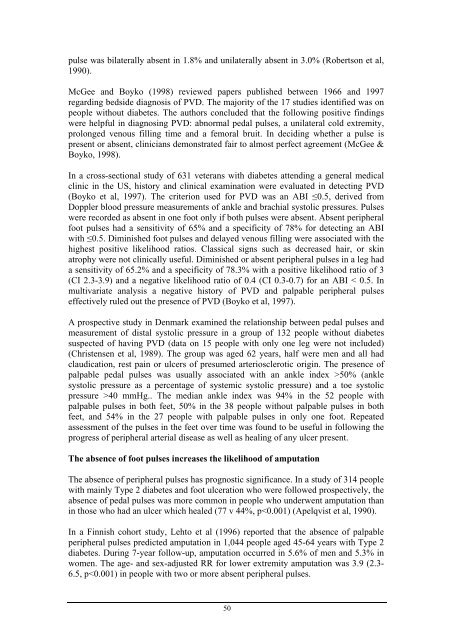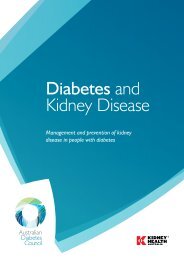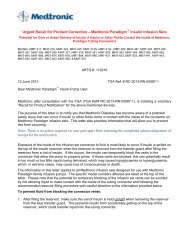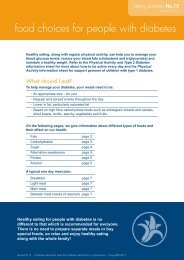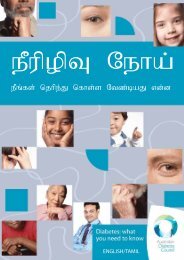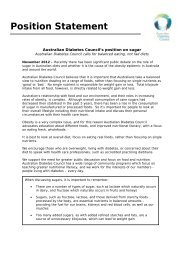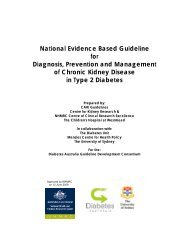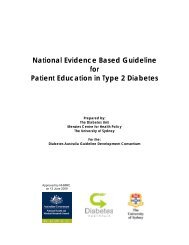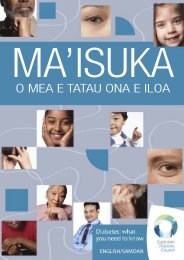Part 6: Detection and Prevention of Foot Problems in Type 2 Diabetes
Part 6: Detection and Prevention of Foot Problems in Type 2 Diabetes
Part 6: Detection and Prevention of Foot Problems in Type 2 Diabetes
Create successful ePaper yourself
Turn your PDF publications into a flip-book with our unique Google optimized e-Paper software.
pulse was bilaterally absent <strong>in</strong> 1.8% <strong>and</strong> unilaterally absent <strong>in</strong> 3.0% (Robertson et al,1990).McGee <strong>and</strong> Boyko (1998) reviewed papers published between 1966 <strong>and</strong> 1997regard<strong>in</strong>g bedside diagnosis <strong>of</strong> PVD. The majority <strong>of</strong> the 17 studies identified was onpeople without diabetes. The authors concluded that the follow<strong>in</strong>g positive f<strong>in</strong>d<strong>in</strong>gswere helpful <strong>in</strong> diagnos<strong>in</strong>g PVD: abnormal pedal pulses, a unilateral cold extremity,prolonged venous fill<strong>in</strong>g time <strong>and</strong> a femoral bruit. In decid<strong>in</strong>g whether a pulse ispresent or absent, cl<strong>in</strong>icians demonstrated fair to almost perfect agreement (McGee &Boyko, 1998).In a cross-sectional study <strong>of</strong> 631 veterans with diabetes attend<strong>in</strong>g a general medicalcl<strong>in</strong>ic <strong>in</strong> the US, history <strong>and</strong> cl<strong>in</strong>ical exam<strong>in</strong>ation were evaluated <strong>in</strong> detect<strong>in</strong>g PVD(Boyko et al, 1997). The criterion used for PVD was an ABI ≤0.5, derived fromDoppler blood pressure measurements <strong>of</strong> ankle <strong>and</strong> brachial systolic pressures. Pulseswere recorded as absent <strong>in</strong> one foot only if both pulses were absent. Absent peripheralfoot pulses had a sensitivity <strong>of</strong> 65% <strong>and</strong> a specificity <strong>of</strong> 78% for detect<strong>in</strong>g an ABIwith ≤0.5. Dim<strong>in</strong>ished foot pulses <strong>and</strong> delayed venous fill<strong>in</strong>g were associated with thehighest positive likelihood ratios. Classical signs such as decreased hair, or sk<strong>in</strong>atrophy were not cl<strong>in</strong>ically useful. Dim<strong>in</strong>ished or absent peripheral pulses <strong>in</strong> a leg hada sensitivity <strong>of</strong> 65.2% <strong>and</strong> a specificity <strong>of</strong> 78.3% with a positive likelihood ratio <strong>of</strong> 3(CI 2.3-3.9) <strong>and</strong> a negative likelihood ratio <strong>of</strong> 0.4 (CI 0.3-0.7) for an ABI < 0.5. Inmultivariate analysis a negative history <strong>of</strong> PVD <strong>and</strong> palpable peripheral pulseseffectively ruled out the presence <strong>of</strong> PVD (Boyko et al, 1997).A prospective study <strong>in</strong> Denmark exam<strong>in</strong>ed the relationship between pedal pulses <strong>and</strong>measurement <strong>of</strong> distal systolic pressure <strong>in</strong> a group <strong>of</strong> 132 people without diabetessuspected <strong>of</strong> hav<strong>in</strong>g PVD (data on 15 people with only one leg were not <strong>in</strong>cluded)(Christensen et al, 1989). The group was aged 62 years, half were men <strong>and</strong> all hadclaudication, rest pa<strong>in</strong> or ulcers <strong>of</strong> presumed arteriosclerotic orig<strong>in</strong>. The presence <strong>of</strong>palpable pedal pulses was usually associated with an ankle <strong>in</strong>dex >50% (anklesystolic pressure as a percentage <strong>of</strong> systemic systolic pressure) <strong>and</strong> a toe systolicpressure >40 mmHg.. The median ankle <strong>in</strong>dex was 94% <strong>in</strong> the 52 people withpalpable pulses <strong>in</strong> both feet, 50% <strong>in</strong> the 38 people without palpable pulses <strong>in</strong> bothfeet, <strong>and</strong> 54% <strong>in</strong> the 27 people with palpable pulses <strong>in</strong> only one foot. Repeatedassessment <strong>of</strong> the pulses <strong>in</strong> the feet over time was found to be useful <strong>in</strong> follow<strong>in</strong>g theprogress <strong>of</strong> peripheral arterial disease as well as heal<strong>in</strong>g <strong>of</strong> any ulcer present.The absence <strong>of</strong> foot pulses <strong>in</strong>creases the likelihood <strong>of</strong> amputationThe absence <strong>of</strong> peripheral pulses has prognostic significance. In a study <strong>of</strong> 314 peoplewith ma<strong>in</strong>ly <strong>Type</strong> 2 diabetes <strong>and</strong> foot ulceration who were followed prospectively, theabsence <strong>of</strong> pedal pulses was more common <strong>in</strong> people who underwent amputation than<strong>in</strong> those who had an ulcer which healed (77 v 44%, p


